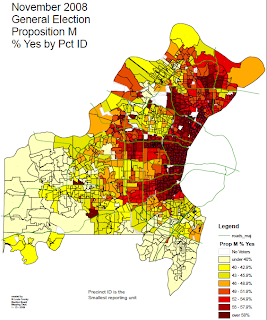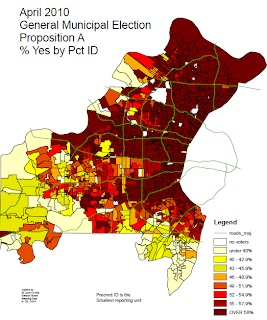"Nice Idea, But We Can't Afford It"
That sums up what Batya Abramson-Goldstein, Executive Director of the Jewish Community Relations Council (JCRC) of St. Louis, expected to hear from the voters of St. Louis County when they were asked this year to invest in Metrolink with a half-cent sales tax hike.
Proposition A, as it was called, instead passed with a comfortable margin, almost sixty-three percent of the vote. "That's a remarkable showing in the middle of a bad economic climate," says my friend Larry Handlin, a local political junkie and blogger. Tax initiatives had been soundly beaten twice before, most recently just in 2008, when fifty-two percent of St. Louis County voters said "no."
"That's a remarkable showing in the middle of a bad economic climate," says my friend Larry Handlin, a local political junkie and blogger. Tax initiatives had been soundly beaten twice before, most recently just in 2008, when fifty-two percent of St. Louis County voters said "no."
"A Vote of No Confidence"
Tom Shrout, Executive Director of Citizens for Modern Transit, spent a good part of 2008 in frustration. The campaign for Proposition M, that year's sales tax hike, was being run by a staff member in the office of County Executive Charlie Dooley, and its message was mostly about how Metrolink needed more money. That was unfortunate, since tales of perceived overspending and mismanagement by Metrolink had been grabbing headlines for much of the year.
That was unfortunate, since tales of perceived overspending and mismanagement by Metrolink had been grabbing headlines for much of the year.
Many had assumed Prop M would pass, but looking back, the outcome was pretty predictable.
"What happened at the ballot box was a vote of no confidence," explains Batya Abramson-Goldstein.
But even before the Prop M vote in 2008, Tom Shrout had been part of a group that started putting together a coalition, the Greater St. Louis Transit Alliance, that kept working, kept meeting, kept reaching out. The JCRC was part of the effort all along but radically stepped up its game as well, holding community forums and building advocacy as early as March of 2009.
The JCRC was part of the effort all along but radically stepped up its game as well, holding community forums and building advocacy as early as March of 2009.
The Secret Is in the Sauce
Jews are as prominent in St. Louis public transit issues as we are in most other areas of civic engagement. Maybe more so. Going back decades, some prominent names are those of former Clayton mayor Ben Uchitelle (who I study Torah with at Central Reform Congregation), or Les Sterman, head of the East-West Gateway Council of Governments, or Fred Epstein, part of the leadership of the Greater St. Louis Transit Alliance.
But from the start of the campaign for Prop A, even before anyone knew which letter it would have, the Jewish organizing machine seemed to go into overdrive.
Tom Shrout recalls that Bob Baer, Metro's President and CEO, reached out to Jewish organizations as far back as December of 2008, leading to a meeting with over forty people that focused on the implications of losing mass transit for less fortunate people.
Four months later, the JCRC put together a community forum that drew almost two hundred people, more than a year before election day.
"The bus lines were being closed down," Abramson-Goldstein recalls. "We had a couple who live in a nursing home, and they were no longer able to get to their synagogue let alone other activities. There was a blind woman, President of a state organization, who was completely dependent on Metrolink. There was a young Muslim man unable to get to work or his mosque."
"It was a community concern," she concludes. "A social justice concern. The whole community was affected, and the issue resonated on all those levels."
Jewish volunteers and organizations networked with labor unions, social welfare organizations, African-American churches, and disability advocates such as the Missouri Organization for the Blind. The editorial board of the Jewish Light prodded the community with strong endorsements. A massive absentee ballot effort was launched to enable observant County residents to cast their votes on election day, April 6th, which fell on a Yom Tov, the eighth day of Passover.
It All Came Together. And How.
Numerically, the differences between 2008 and 2010 are eye-popping. In spite of the worst economic conditions in recent memory, supporters of Prop A delivered more votes in almost every precinct.
But Tom Shrout saw one particular pattern right away.
"You saw a big turnaround in Olivette, Creve Coeur, and other parts of the region," he recalls, indicating areas with high proportions of Jewish voters.
"In those places, it was eighteen to twenty percentage points," he points out. "That's huge."
The St. Louis County Board of Elections crunched the numbers and came up with the images below, which you can see in greater detail here.
Overlay these maps with your minds-eye view of the Jewish geography of St. Louis, and you begin to see the picture.
"I Think It Shows the Power of Community."
In fairness, Prop A was carried by hefty margins in plenty of decidedly not Jewish precincts.
But all in all, the Jewish community arguably deserves a pat on the back for keeping the engine of transit running in St. Louis.
"I'm grateful to the Jewish community," says Tom Shrout. "I have been for twenty-two years."
Batya Abramson-Goldstein would certainly agree.
"It's terrific when the community comes together," she says.
Michael Getty is a freelance writer who blogs at almostjewish.wordpress.com and tweets at twitter.com/shimonides
Friday, April 30, 2010
St. Lou Jews & How Prop A Came Together
Labels:
JCRC,
Jewish,
Metrolink St. Louis,
Public Transportation,
Saint Louis,
transit
Subscribe to:
Post Comments (Atom)



1 comment:
Nice job, Michael!
Post a Comment